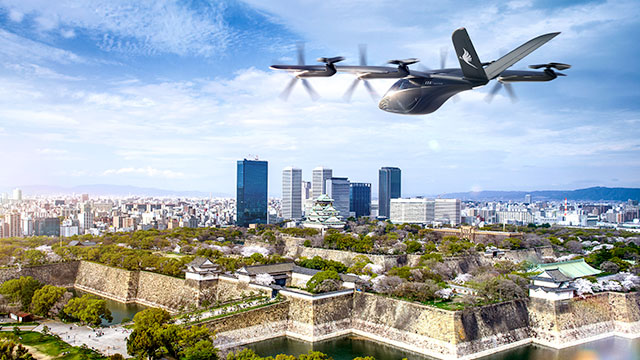An Air Mobility Revolution Takes Off:
The Japan-U.K.-U.S. Team Making Flying Taxis a Reality
Designing a Future Where Flying Taxis Are a Common Mode of Transportation

You mostly work from home, surrounded by mountains. When you need to go to the office in Tokyo, you take a fast and comfortable “flying taxi.” A dream lifestyle like this one may become a reality in the not-so-distant future.
Aiming to achieve commercial operations that would enable this reality, various companies in the world are ramping up the development of flying taxis, a brand-new concept aircraft called “electric Vertical Take-Off and Landing” (eVTOL), which has been hailed as a mobility revolution that only occurs once in 100 years. The new aircraft can take off and land vertically without needing a runway. Powered by electricity charged in a battery, it can fly without emitting any greenhouse gasses, and its noise level is very low. Because the aircraft is made up of few parts, maintenance costs will also be kept low. Once they become prevalent, the fares per kilometer of flying taxis are expected to be nearly equal to those of conventional taxis on the ground. It is also hoped that the aircraft can help solve some social problems by reducing traffic congestion in urban areas while creating new means of transportation in rural, underpopulated areas.
In 2021, Marubeni’s efforts to create this brand-new industry, air mobility—convenient and affordable air transportation—began in earnest. By signing a partnership agreement with Vertical Aerospace Group Ltd. of the United Kingdom, Marubeni has acquired the rights to pre-order 200 eVTOL aircraft that the company has been developing. It is expected that the five-seater (including the cockpit) aircraft, VX4, will be certified by the European Union Avian Safety Agency (EASA) by 2026 and then start operating commercially in the U.K. and other parts of Europe, followed by Japan and other parts of Asia. Beyond that, Vertical Aerospace is aiming to make a shift to a self-flying mode in the future.
Set out on a journey in a flying taxi!
The main pillar of Marubeni’s air mobility business will be to bring in the VX4 to Japan and provide flight-operation services; the company sees great potential for flying taxis, particularly in tourism. “There are alluring tourist destinations across Japan, many of which are not easily accessible,” says Atsushi Takao, a member of Aviation Section III, part of Marubeni’s Aviation, Space & Defense Department. “In many cases, you have no choice but to drive a long distance, going around a peninsula, for example.”
Teaming up with three other companies, Marubeni conducted trial package tours from December 2022 to January 2023, simulating eVTOL flights to a tourist destination that currently requires a long road trip. This was one of the Proof-of-Concept (PoC) projects sponsored by the Osaka prefectural government that aims to kickstart point to point transport using flying taxis at EXPO 2025 Osaka, Kansai. The purpose of the trial tours, which transported the participants by helicopter between Osaka and a resort hotel situated in the southeast of the Kii Peninsula, was to measure the societal acceptance of air mobility as well as gather participants’ feedback on the price and the experience. The roundtrip fare, JPY 40,000 (about USD 300), was set to reflect a projected passenger price in the future when flying taxis are running frequently. To go to the hotel, it usually takes about four hours by car as opposed to 50 minutes by helicopter. The VX4, which boasts a 325 km/h top speed, can save even more time. Overall, the trial tours were a success, with participant feedback including such comments as, “I was amazed at the tremendous amount of time that was saved by taking the flying taxi,” and, “This was absolutely worth the round-trip fare of 40,000 yen.”
Leading the “Team Effort”
In March 2023, eVTOL flight demonstration using HEXA, a one-seater aircraft developed by Lift Aircraft Inc., United States was conducted in Osaka. In addition to assessing the environmental impact (such as noise levels), the demonstration was aimed primarily at helping raise public acceptance and awareness of the flying taxi. The experiment was positively received, with participants showing interest in using the aircraft to attract tourists.
“We want to make the flying taxi an affordable means of transportation which people can actually use, rather than a rare, relatively inaccessible form of transportation like a helicopter,” Takao says. To make that happen, establishing ground infrastructure, including vertiports that are easy to get to, charging stations, and garages for aircraft, as well as training pilots and mechanics, are key developments. There are many other issues to explore; identifying potential yet undiscovered demand is one of them. “Marubeni cannot do any of these things alone,” says Yuichi Yoshikawa, who leads Marubeni’s team at Aviation Section III of the Aviation, Space & Defense Department. In an effort to build the foundation for the new industry, Marubeni has been actively reaching out to various companies and municipalities, bringing people together to create a collective force. Yoshikawa anticipates that progress will be accelerated going forward because some concrete ideas, such as where to set up vertiports, are now being born. “In our capacity as a general trading company, we are tasked with leading the ‘team effort’ effectively. We want to help shape this challenging work—creating a new form of mobility.”

